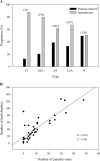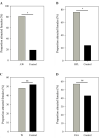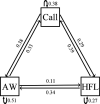Parasite defensive limb movements enhance acoustic signal attraction in male little torrent frogs
- PMID: 35522043
- PMCID: PMC9122496
- DOI: 10.7554/eLife.76083
Parasite defensive limb movements enhance acoustic signal attraction in male little torrent frogs
Abstract
Many animals rely on complex signals that target multiple senses to attract mates and repel rivals. These multimodal displays can however also attract unintended receivers, which can be an important driver of signal complexity. Despite being taxonomically widespread, we often lack insight into how multimodal signals evolve from unimodal signals and in particular what roles unintended eavesdroppers play. Here, we assess whether the physical movements of parasite defense behavior increase the complexity and attractiveness of an acoustic sexual signal in the little torrent frog (Amolops torrentis). Calling males of this species often display limb movements in order to defend against blood-sucking parasites such as frog-biting midges that eavesdrop on their acoustic signal. Through mate choice tests we show that some of these midge-evoked movements influence female preference for acoustic signals. Our data suggest that midge-induced movements may be incorporated into a sexual display, targeting both hearing and vision in the intended receiver. Females may play an important role in incorporating these multiple components because they prefer signals which combine multiple modalities. Our results thus help to understand the relationship between natural and sexual selection pressure operating on signalers and how in turn this may influence multimodal signal evolution.
Keywords: Amolops torrentis; ecology; evolutionary biology; mate choice; multimodal communication; natural selection; parasite; pre-existing bias.
© 2022, Zhao et al.
Conflict of interest statement
LZ, JW, HZ, TW, YY, YT, WH, JC No competing interests declared
Figures








Comment in
-
Response to comment on 'Parasite defensive limb movements enhance acoustic signal attraction in male little torrent frogs'.Elife. 2023 Oct 9;12:e90404. doi: 10.7554/eLife.90404. Elife. 2023. PMID: 37812200 Free PMC article.
-
Comment on 'Parasite defensive limb movements enhance acoustic signal attraction in male little torrent frogs'.Elife. 2023 Oct 9;12:e89134. doi: 10.7554/eLife.89134. Elife. 2023. PMID: 37812202 Free PMC article.
Similar articles
-
Response to comment on 'Parasite defensive limb movements enhance acoustic signal attraction in male little torrent frogs'.Elife. 2023 Oct 9;12:e90404. doi: 10.7554/eLife.90404. Elife. 2023. PMID: 37812200 Free PMC article.
-
Comment on 'Parasite defensive limb movements enhance acoustic signal attraction in male little torrent frogs'.Elife. 2023 Oct 9;12:e89134. doi: 10.7554/eLife.89134. Elife. 2023. PMID: 37812202 Free PMC article.
-
Synchronized mating signals in a communication network: the challenge of avoiding predators while attracting mates.Proc Biol Sci. 2019 Oct 9;286(1912):20191067. doi: 10.1098/rspb.2019.1067. Epub 2019 Oct 9. Proc Biol Sci. 2019. PMID: 31594513 Free PMC article.
-
From uni- to multimodality: towards an integrative view on anuran communication.J Comp Physiol A Neuroethol Sens Neural Behav Physiol. 2014 Sep;200(9):777-87. doi: 10.1007/s00359-014-0923-1. Epub 2014 Jun 29. J Comp Physiol A Neuroethol Sens Neural Behav Physiol. 2014. PMID: 24973893 Free PMC article. Review.
-
Mating vocalizations of female frogs: control and evolutionary mechanisms.Brain Behav Evol. 1999;53(4):187-97. doi: 10.1159/000006594. Brain Behav Evol. 1999. PMID: 10343085 Review.
Cited by
-
Avian Alarm Calls Do Not Induce Anti-Predator Response in Three Anuran Species.Animals (Basel). 2022 Dec 14;12(24):3537. doi: 10.3390/ani12243537. Animals (Basel). 2022. PMID: 36552456 Free PMC article.
-
Response to comment on 'Parasite defensive limb movements enhance acoustic signal attraction in male little torrent frogs'.Elife. 2023 Oct 9;12:e90404. doi: 10.7554/eLife.90404. Elife. 2023. PMID: 37812200 Free PMC article.
-
Comment on 'Parasite defensive limb movements enhance acoustic signal attraction in male little torrent frogs'.Elife. 2023 Oct 9;12:e89134. doi: 10.7554/eLife.89134. Elife. 2023. PMID: 37812202 Free PMC article.
-
Snake-like bird hisses induce anti-predator responses in a frog.BMC Ecol Evol. 2024 Oct 12;24(1):126. doi: 10.1186/s12862-024-02312-4. BMC Ecol Evol. 2024. PMID: 39394096 Free PMC article.
References
-
- Andersson M. Sexual Selection. Princeton, NJ: Princeton Univ. Press; 1994. - DOI
-
- Bernal X.E., Rand AS, Ryan MJ. Acoustic preferences and localization performance of blood-sucking flies (Corethrella Coquillett) to túngara frog calls. Behavioral Ecology. 2006;17:709–715. doi: 10.1093/beheco/arl003. - DOI
-
- Bradbury JW, Vehrencamp SL. Principles of Animal Communication. Sinauer Press; 1998.
Publication types
MeSH terms
Associated data
LinkOut - more resources
Full Text Sources

